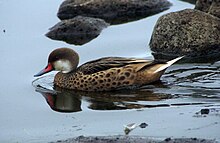The white-cheeked pintail (Anas bahamensis), also known as the Bahama pintail or summer duck,[2] is a species of dabbling duck. It was first described by Carl Linnaeus in his landmark 1758 10th edition of Systema Naturae under its current scientific name.[3]
| White-cheeked pintail | |
|---|---|
 | |
| Anas bahamensis galapagensis | |
| Scientific classification | |
| Domain: | Eukaryota |
| Kingdom: | Animalia |
| Phylum: | Chordata |
| Class: | Aves |
| Order: | Anseriformes |
| Family: | Anatidae |
| Genus: | Anas |
| Species: | A. bahamensis |
| Binomial name | |
| Anas bahamensis | |
| Subspecies | |
 | |
Distribution and habitat
It is found in the Caribbean, South America, and the Galápagos Islands.[4] It occurs on waters with some salinity, such as brackish lakes, estuaries and mangrove swamps.[4]
There are three subspecies:
- A. b. bahamensis—lesser Bahama pintail[2]—in the Caribbean, and a vagrant to southern Florida
- A. b. rubirostris—greater Bahama pintail[2]—in South America; it may be partly migratory, breeding in Argentina and wintering further north.[4]
- A. b. galapagensis—Galápagos pintail[2]—in the Galápagos Islands
Description
Like many southern ducks, the sexes are similar. It is mainly brown with white cheeks and a red-based grey bill (young birds lack the pink). It cannot be confused with any other duck in its range.[4]
Behaviour
The white-cheeked pintail feeds on aquatic plants (such as Ruppia), grass seeds, algae[5][6] and small creatures (such as insects and small aquatic invertebrates)[5][6] obtained by dabbling. The nest is on the ground under vegetation and near water.[4]
Aviculture
It is popular in wildfowl collections, and escapees are frequently seen in a semi-wild condition in Europe. A leucistic (whitish) variant is known in aviculture as the silver Bahama pintail.[2]
Gallery
- Caribbean white-cheeked pintail with 9 ducklings
- Adult on left with red at the base of its beak and a juvenile with an all black bill on the right
- Whitish variant
- Two white-cheeked pintails on the Island of Santa Cruz in the Galápagos Islands
- Taken in the Galápagos Islands
References
External links


- White-cheeked pintail videos, photos, and sounds on the Internet Bird Collection








